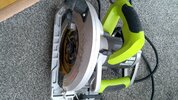I am cutting kitchen worktop and used a circular saw and noticed the end of the cut is not square where the start of the cut is. Its a works saw with a De Walt blade. Is it technique or is something else going on.
See left side bottom is not square. You are looking at the front edge of the worktop I started the cut from the back to the front. The right side edge in the picture is the factory cut. Its not that rough its just pixelated - the cut is very good.



For my next cuts I plan to cut slightly oversize and square off with my router. Or put it on my table saw as some pieces are only 1m and 500mm
See left side bottom is not square. You are looking at the front edge of the worktop I started the cut from the back to the front. The right side edge in the picture is the factory cut. Its not that rough its just pixelated - the cut is very good.


For my next cuts I plan to cut slightly oversize and square off with my router. Or put it on my table saw as some pieces are only 1m and 500mm

